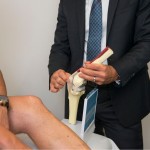Conditions / Sports Injuries
Muscle Tears

Muscle tears are one of the most common injuries that are treated by orthopaedic surgeons.
Not all injuries require surgery, but all require management and treatment. Some of the most common muscle tears that are regularly treated by Dr Shidiak include:
Meniscal tear: Find information on this under Meniscus Injuries on this website
Anterior Cruciate Ligament (ACL) tear: One of the most common knee injuries is an anterior cruciate ligament sprain or tear. Find information on this under ACL tears on this website
Hamstring tear:
The hamstring is a group of muscles, located on the back of the upper leg. There are three separate muscles that make up the hamstring being the Biceps Femoris, Semimembranosus and Semitendinosus.
At the top end, these muscles are attached to the lower part of the pelvis, and at the bottom end they are attached to the tibia and fibula (shin bones) just below the knee joint.
The hamstring muscles function is to flex (bend) the knee and extend (straighten) the hip.
The hamstring muscle group is very susceptible to tears and strains and therefore hamstring tears are one of the most common injuries in sport – particularly in sports requiring a high degree of speed, power and agility such as football. As team doctor the Parramatta Eels, Dr Shidiak has treated many athletes who have experienced a hamstring tear.
Hamstring tears are classified as Grade 1–3 depending on the severity. With Grade 1 being the mildest and Grade 3 the most severe. A Grade 3 hamstring tear (referred to as a rupture) may require surgical repair.


Quadricep tear:
The quadriceps muscles is a group of muscles located on the front of the thigh. There are four muscles in this group being the vastus lateralis, vastus medialis, vastus intermedius and the rectus femoris.
Quadriceps tendon tears can be either partial or complete. Partial tears in many instances don’t completely disrupt the soft tissue. This is similar to a rope stretched so far that some of the fibers are frayed, but the rope is still in one piece.
Complete tears split the soft tissue into two piece, cause intense pain and limit the ability to walk.
The quadriceps are more vulnerable to injury when a thorough warm-up hasn’t been undertaken. The most common tears occur in the rectus femoris as it is the only muscle in the group that crosses both the hip and the knee joints.


